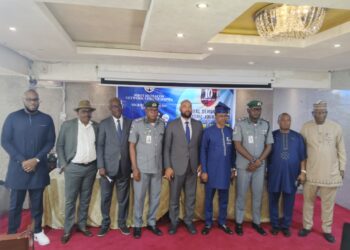Maritime History brings to memory historic experiences shared by people in different areas of the maritime industry. Also, we capture fleeting moments along the coast and we want our audience to enjoy the collections of the sea in diverse forms.
On this occasion of Maritime History, a very pleasant friend of the house and a former Group Managing Director at NAL- COMET Group, PierLuigi Carrodano, shares his experience in the maritime space for over six decades now.
First, he talks about how shipping eras have shaped global shipping.
Maritime History Chat – The advent of the LIBERTY type vessels and Containers
The Liberty ships were a class of cargo ships built by the United States during World War II.
They were designed for efficiency and mass production, with a simple design and standardised components to enable quick construction. The purpose of these ships was to transport supplies, troops, and equipment to support the war effort.
It is said that during total production, one Liberty-type vessel was built per day, considering the many shipyards involved in the construction.
Liberty ships were utilised by various nations, primarily by the United States, the United Kingdom, and the Soviet Union. They played a crucial role in ensuring the flow of supplies across the Atlantic and Pacific oceans. These ships were used to transport goods like food, ammunition, vehicles, and other essential supplies to both the European and Pacific theatres of the war.
They were named after prominent Americans and were operated by a range of organisations, including private shipping companies, the U.S. Navy, and the British Ministry of War Transport. Their construction was a remarkable feat of industrial production, contributing significantly to the logistical capabilities of the Allied forces during the war.
Liberty ships were equipped with diesel engines, which were more fuel-efficient and required less maintenance than steam engines. These made them more suitable for long voyages and reduced the need for frequent maintenance stops.
Due to the technology available at the time, Liberty ships were not highly automated. As a result, they required a crew of around 30 to 35 members to operate various tasks on board, such as navigation, engine operation, cargo handling, and maintenance. At that time it was considered a relatively small crew size.
The carrying capacity of a Liberty ship, also known as its deadweight tonnage (DWT), varied slightly among different ships due to minor design modifications and improvements throughout their production. On average, a Liberty ship had a deadweight tonnage of around 10,800 to 11,000 metric tons. This means they could carry a total cargo weight, fuel, and supplies up to that amount while maintaining buoyancy and stability. This is an approximate range, as individual Liberty ships could have slight variations in their carrying capacity.
After World War Il, many surplus Liberty ships were sold at low prices, presenting a significant opportunity for entrepreneurs to acquire and repurpose them for commercial use. Greek shipping magnate Aristotle Onassis was one of the prominent figures who took advantage of this situation. He purchased surplus Liberty ships and other vessels at low cost, significantly building his vast shipping empire.
The availability of these inexpensive ships allowed entrepreneurs to enter the shipping industry and capitalize on the post-war demand for transportation and trade. This period marked a transformative phase in the shipping industry and contributed to the expansion of maritime commerce in the years following World War II.
The utilisation of Liberty vessels is one of the very few transformations in the shipping industry contributing to the expansion of maritime commerce. The other known major transformations are the switch from sails to engines and, the advent of containerization
The development of advanced technology and digitalization
These technological advancements have significantly transformed how goods are transported by sea, enhancing efficiency, safety, and sustainability across the maritime sector.
The transition from sail-powered merchant ships to engine-powered vessels occurred gradually over several decades during the late 19th and early 20th centuries. The timeline can vary depending on the specific regions and types of ships, but here’s a general overview:
- Mid-19th Century: The mid-1800s saw the emergence of steam engines in maritime use.
Steamships began to complement sail power on certain routes and for specific purposes, such as river transport, coastal trade, and short-haul journeys.
- Late 19th Century: Towards the end of the 19th century, steam engines became more reliable and efficient. Many ships started using steam engines as their primary propulsion for longer voyages, as they offered more consistent power and reduced reliance on favourable winds.
- Early 20th Century: By the early 20th century, steam engines had become the dominant propulsion for merchant vessels and this period also marked the transition from reciprocating steam engines to more efficient and powerful steam turbines
- Mid-20th Century: The mid-20th century saw diesel engines’ introduction and gradual adoption as a more fuel-efficient alternative to steam propulsion. Diesel engines were easier to operate, required less manpower, and were more adaptable to various ship sizes and types.
While engine-powered ships were becoming more common, there were still sailing vessels for specialised purposes, such as training ships, fishing vessels, and specific regional trades. The advent of motorized ships and the development of more advanced engine technologies eventually led to the near extinction of commercial sailing vessels as primary cargo carriers.
Overall, the transition from sail to engine power was a transformative period in maritime history, significantly impacting merchant ships’ efficiency, speed, and capabilities.
The concept of containerization, where standardized containers are used to transport goods, began to take shape in the mid-20th century.
The key developments in container shipping occurred during the following periods:
1.1950s: The concept of containerisation was pioneered by American entrepreneur Malcolm Mclean. In 1956, his company, the International Shipping Company (later known as Sea-Land Service, Ine.), conducted the first successful test of containerised cargo transport. The idea was to use standardised containers that could be quickly loaded onto ships, trucks, and trains, streamlining the process of transferring goods between different modes of transportation.
- Late 1950s to 1960s: Mclean’s concept gained momentum, and container shipping started to gain acceptance in the industry. The first dedicated container ship, the SS Ideal X, was launched in 1956. In the late 1960s, standardised container sizes, such as the 20-foot and 40-foot containers, further facilitated the efficient loading and unloading of ships and other transportation modes.
- 1970s: The introduction of containerization led to a significant transformation of the shipping industry. Ports were adapted to handle containerized cargo, and container terminals equipped with cranes and infrastructure emerged around the world. This era saw the growth of major container shipping companies, such as Maersk, Evergreen, and Mediterranean Shipping Company (MSC).
- 1980s to Present: Containerization continued to expand, becoming the dominant method of international cargo transport. Advancements in container design, handling equipment, and logistics technologies further optimized the process. Integrating computer systems and digital tracking allowed for better management of container flows and supply chains.
Containerization revolutionized the shipping industry by reducing cargo handling times, minimizing theft and damage, and increasing the speed and efficiency of global trade. It has become a foundational element of modern logistics and trade, enabling goods to be transported seamlessly worldwide.
Benefits of shipping transformation
Without shipping, the civilization seen today would not have been there. God made the earth and placed the raw materials in different far locations. So, transporting them is very important and that is what we see, advancement.
Personal Experience
The octogenarian, an Italian national, who has enjoyed the warmth of Nigeria for the past 50 years, wants us to appreciate how shipping has passed through several eras. The passage of time through the eras have embraced remarkable changes and Carrodano believes that technology has played a very significant role too, making ships to be more efficient with regards to trade; movement of people and cargoes from one location to the other. Opening the conversation about how he started with the maritime industry, Carrodano said: “For me it was a long journey in shipping and over the years I have accumulated the experience, but above all, the knowledge from the past.”
For a work life started in the environment of shipping, Carrodano has stayed in this space and wants to enjoy the lifetime experience.
Beginning of the journey into maritime
It was around 1961-1962, and it was in La Spezia, which has a very good harbor- Northwest Italy, and not far from Genoa. It is a naval and merchant port.
I started as a young ship agent and I did the essential. For instance, one of the first duties was to help clear the vessels; when vessels come from overseas they would be cleared first by the port health, then the Customs, Immigration and so on.
The spectacular thing was to receive the health team and then to immigration and a series of documents to show, like the Yellow Book of each member to show that there was no sickness on board. Then, Customs would check for anything pertaining to dutiable goods like liquor and provisions on board. Then, Immigration would check the identity of each member. This process would last for one hour or sometimes more. Sometimes they would check the cabin to see whether there are any illegal things like arms, drugs.
Moving to the maritime industry in Nigeria
I came to Nigeria in 1973 as a manager in Panalpina World Transport Company, and I started my first experience with this wonderful country. It was a very big experience, which I keep for myself. I spend more time in Nigeria than anywhere else.
The special thing about the maritime industry in Nigeria
Well, shipping is an international activity, so the functions of shipping are applied anywhere, in the same way. So, I didn’t experience anything strange. But, I would say that as at that time, Nigeria was among the advanced shipping countries; NPA was already in existence. But everything was new for me and I was well accepted. There were Nigerian Pilots, there were Pilots from India, but also from Egypt, because at that time, there was a crisis and they closed the Suez Canal. So, many Egyptians came to Nigeria to work. I was a manager in Panalpina, in Port Harcourt, Rivers State. That was my first experience in Nigeria. Apart from a few times I was away working in America and Italy, my work life has always been in Nigeria.
Growth of the maritime industry in Nigeria
There has been a big transformation.
Nigeria is a big import- export country, and in terms of volumes, it is the biggest in West Africa. All the major shipping lines have been very keen to trade in Nigeria, they need Nigeria, because without Nigeria they may not be able to apply their services in West Africa. Nigeria accounted for 70% of the cargoes in West Africa. So, anyone (shipping line) plying the routes in West Africa needs Nigeria. We know that in West Africa it was the NNSL, and then the Black Stars Line, Ghana. And where there is need for shipping is where there is prosperity and advancement. Nigeria is very important for anyone in shipping, because you consider the size of the country and the population of the people.
On the flipside
I love the sea and am attracted to doing sea activities such as fishing and yachting. In my opinion, fishing has always been very attractive and as a pastime, I can spend hours in the sun catching fish for leisure. Then, I have a boat, but not large, which I use to sail. The boat is very easy to maintain because of its size and you don’t need much maintenance. I only use the boat once in a while. I decided to experience crossing the ocean and it was very good. We were four of us sailing and we started in November 2014, and the trade wind always blew in the same direction towards West. That explains why Christopher Columbus was able to cross and landed on the other side of the water to form America. At that time it was said to be in India. So, we started in November and went from Las Palmas to Cape Verde in five days. Then, we sailed to Saint Lucia in the Caribbean, in 13 days. It was inspiring!
At the same time I was busy because we had to do six hours each watching because of safe navigation. The most difficult time was during cooking! But it was a good experience and I had the opportunity to see the ocean. But I was not so happy to see remnants of fishing nets and it means pollution. But I see a lot of advancement now, because a lot more people have become conscious. The trend is to be more environmentally efficient; that is very important. I remember many years ago in Italy, the habit was that of throwing away many things people thought they didn’t need. But that is changing and I believe we can still make the change.
































































